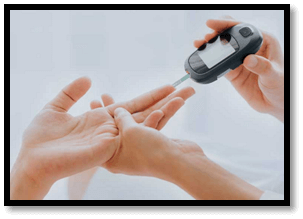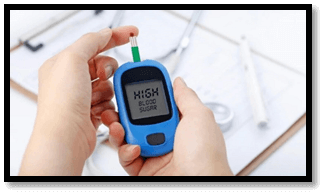Diabetes Mellitus DefinitionDiabetes, also known as diabetes mellitus, is a group of metabolic diseases characterized by chronically high blood sugar levels. The most common symptoms include increased thirst, hunger, and frequent urination. If diabetes is not treated, it may have a lot of negative effects on one's health. Chronic consequences include death, diabetic ketoacidosis, and hyperosmolar hyperglycemia. Some severe long-term effects include cognitive impairment, heart disease, stroke, renal issues, foot ulcers, vision problems, nerve damage, and eye damage. 
Diabetes is brought on by either inadequate pancreatic insulin synthesis or inappropriate insulin uptake by body cells. For the purpose of cellular energy usage, the hormone insulin is responsible for enabling the entry of glucose received from food into cells. Types of DiabetesThe primary kinds of diabetes mellitus are as follows: 1. Type 1 DiabetesOnce the pancreas cannot create enough insulin, Type 1 diabetes happens because beta cells are lost. Previously, this kind was referred to as "insulin-dependent diabetes mellitus" or "juvenile diabetes." Beta cell loss results from an immunological response. There is no known etiology for this autoimmune response. Type 1 diabetes can manifest in adults, although it typically first appears in children or adolescents. 2. Type 2 DiabetesType 2 diabetes is preceded by the condition known as insulin resistance, wherein the cells do not respond to insulin the way they should. As the problem gets worse, an insulin deficit might also develop. Adult-onset diabetes or non-insulin-dependent diabetes mellitus was the previous name for this form of diabetes. Type 2 diabetes generally affects older individuals more commonly; however, it is now more common in younger people due to a sharp increase in rates of childhood obesity. The most prevalent cause is having an excessive amount of body weight combined with insufficient exercise. 3. Gestational DiabetesGestational diabetes, the third primary type of diabetes, tends to affect pregnant women who have never suffered the condition. When women suffering from gestational diabetes give delivery, their blood sugar levels frequently function normally within a few days. Pregnant women with gestational diabetes mellitus have a higher risk of developing type 2 diabetes later on in life. 4. Other types of Diabetes"Maturity-onset diabetes of the Young" (MODY) is an uncommon autosomal dominant hereditary form of diabetes caused by one of many single-gene abnormalities that impair insulin synthesis. With only 1-2% of instances, it is much less frequent than the three primary categories. The disease's name alludes to early theories about its makeup. There are currently at least 13 subtypes of MODY due to the fact that a faulty gene causes this disease and that each subtype has a different age of presentation and severity. People with MODY may frequently manage it without insulin. Type 1 diabetes can only be managed with insulin injections. A balanced diet, regular exercise, maintaining a healthy body weight, and quitting smoking are all effective ways to prevent and cure type 2 diabetes. Oral anti-diabetic drugs, either with or without insulin, can be used to treat type 2 diabetes. People with the condition must control their blood pressure & maintain good foot and eye hygiene. Oral medications and insulin can both produce low blood sugar levels (hypoglycemia). When someone has type 2 diabetes, weight loss surgery may be a viable treatment option. After the baby is born, gestational diabetes typically disappears. As of 2019, there have been 463 million people with diabetes worldwide (8.8% of the adult age group), having type 2 diabetes making up most cases (around 90%). Similar rates apply to both men and women. Rates are likely to keep increasing, according to trends. The chance of dying young is at least doubled in people with diabetes. In 2019, 4.2 million fatalities were attributed to diabetes. It ranks as the sixth leading cause of death globally. Diabetes-related medical costs were estimated to have cost the world economy $727 billion in 2017. In 2017, the expense of diabetes in the US was close to $327 billion. Diabetes patients spend, on average, 2.3 times more on medical care. Symptoms and signsThe top diabetes warning signs and symptoms are listed below: Uncontrolled diabetes is frequently characterized by unintentional weight loss, increased urination, thirst, hunger, and polydipsia (increased hunger). While symptoms of type 1 diabetes might arise quickly (within several weeks or months), those of type 2 diabetes can appear gradually or not at all. 
Despite not being diabetes-specific, a number of additional symptoms and signs can indicate the beginning of the disease. In addition to the symptoms already stated, they also include itchy skin, blurred vision, headaches, and fatigue. The cornea of the eye may absorb glucose due to persistently high blood sugar levels, altering its shape and obstructing vision. Long-term vision loss may occur as a result of diabetic retinopathy. A set of skin illnesses known as diabetic dermadromes can appear in patients with diabetes. DiagnosisA positive outcome should be confirmed by performing any of the above procedures the following day if there are no obvious signs of clearly increased blood sugar. Due to its challenging measurement and lengthy completion time, the formal serum glucose test is not advised. It takes two hours to perform and has no predictive advantage over the fasting test. Two fasting blood glucose readings that are higher than 7.0 mmol/L (126 mg/dL) are currently regarded as diagnostic for diabetes mellitus. According to the WHO, blood sugar values between 6.1 & 6.9 mmol/L (110 to 125 mg/dL) are indicative of those who have issues with fasting glucose. Two hours after ingesting a 75-gram oral glucose load, poor glucose intolerance is defined as plasma glucose levels that are 7.8 mmol/L (140 mg/dL) or above but not 11.1 mmol/L (200 mg/dL). The second of these two prediabetic conditions are particularly dangerous for developing into full-blown diabetes mellitus and heart disease. The 'American Diabetes Association' has recommended impaired fasting glucose within the range of 5.6 to 6.9 mmol/L (100 - 125 mg/dL) since 2003. (ADA). For assessing the likelihood of developing cardiovascular disease and dying from any cause, glycated haemoglobin is preferable to fasting glucose. 
PreventionThere is no established preventive method for type 1 diabetes. In many situations, type 2 diabetes, which accounts for 85-90% of cases worldwide, can be avoided or delayed by maintaining normal body weight, engaging in regular exercise, and eating a healthy diet; when you engage in more physical exercise, your risk of getting diabetes drops by 28% (More than 90 mins per day). It has been demonstrated that maintaining a diet rich in whole grains and fibre, as well as picking healthy fats such as the polyunsaturated fats found in nuts, vegetable oils, and fish can help avoid diabetes. Red meat consumption should be reduced, as should the consumption of other foods high in saturated fat. Diabetes can also be controlled by restricting sugary beverages and foods. Due to the association between tobacco use and an increased risk of developing diabetes and its complications, quitting smoking can be a crucial preventive strategy. The primary modifiable risk factors for type 2 diabetes (obesity, poor diet, inactivity, and tobacco use) share a similar association across all geographical areas. The major elements driving social, economic, and cultural change-globalization, urbanization, population ageing, and the overall environment for health policy-are reflected in the underlying drivers of diabetes, according to mounting data. Problems and issuesAll forms of diabetes carry a higher risk of long-term complications. These typically manifest between ten and twenty years (10-20); however, they could be the first symptom in individuals who have not yet received a diagnosis. The main chronic problems are brought on by blood vessel injury. Patients with diabetes are twice as likely to develop cardiovascular disease, and coronary heart disease is responsible for around 75% of their fatalities. Peripheral artery disease and stroke are two other macrovascular disorders. Additionally, a significant risk factor for serious COVID-19 sickness these consequences. Damage to the kidneys, eyes, and nerves is among the main consequences of diabetes brought on by small blood vessel damage. Damage to the eye's blood vessels, or diabetic retinopathy, can cause progressive vision loss and eventually blindness. 
Glaucoma, cataracts, and some other eye conditions are also more common in those with diabetes. Annual consultation with an ophthalmologist is advised for those with diabetes. Diabetes-related kidney damage, or diabetic nephropathy, can result in protein loss in the urine, tissue scarring, and kidney problems, which may require dialysis or a kidney transplant. Diabetes' most prevalent adverse impact, diabetic neuropathy, harms the body's nerves. The symptoms can cause skin damage by causing numbness, sudomotor dysfunction, tingling, discomfort, and altered pain perception. It is possible for diabetic foot problems (such as diabetic foot ulcers) to develop, which can be challenging to treat. On rare occasions, amputation may be necessary. Painful muscular atrophy and weakening are additional symptoms of proximal diabetic neuropathy. Diabetes and cognitive impairment are related. People with diabetes experience a 1.2 to 1.5 times faster loss of cognitive function than people without the condition. The risk of falls increases in elderly adults with diabetes, especially while taking insulin.
Next TopicDisinfection Definition
|
 For Videos Join Our Youtube Channel: Join Now
For Videos Join Our Youtube Channel: Join Now
Feedback
- Send your Feedback to [email protected]
Help Others, Please Share









